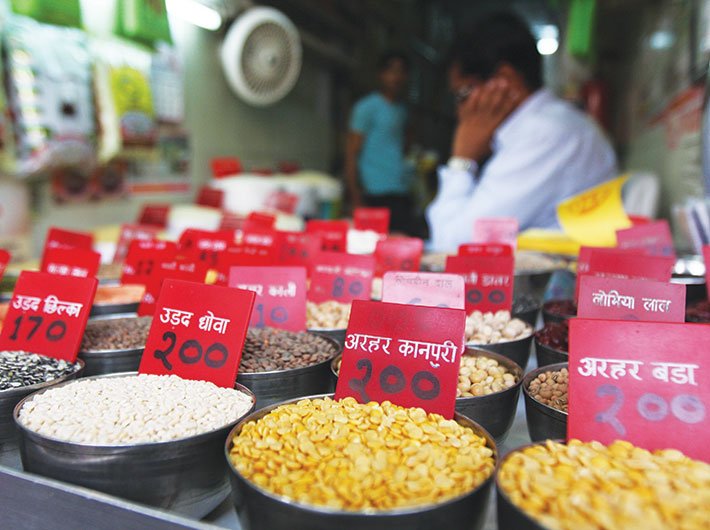As the prices of pulses in India shoot up pushing this essential source of protein for most Indians out of the food basket of many families and communities, Sonal Matharu sits with Dipa Sinha, economist and advisor on child nutrition under the supreme court commissioners office on the right to food case, to understand – as a non-specialist – the reasons and implications of the price rise.
Why the pulse prices are high
The single biggest factor responsible for high pulse prices is its low production in the country. India is the biggest consumer of pulses in the world but the country’s production has always been lower than its consumption. This year production has been particularly low due to two years of deficient and untimely rains.
The production has fallen from 19.8 million metric tonnes in 2013-14 to 17.4 million metric tonnes in 2014-15. The country’s overall pulse production is limited, so a drop of about two million tonnes is significant. The per capita availability of pulses is also going down.
It is a serious issue and a close look is required to assess why the pulse production is going down in a country where it is the main source of protein. Pulses are also common in some African countries but people there also consume a lot of meat, so they are not dependent on pulses for their protein requirements.
Prices of pulses usually go up during the festive season, but not the way they have spiralled this time.
Why pulse production is falling
Pulses are not grown the way rice and wheat are grown in the country. There has been no technological innovation in pulses the way India has seen in rice and wheat. The agricultural policy has been skewed from the beginning, as Green Revolution focused on agricultural innovation and research in a few selected crops. In the 1950s-60s, when food self-sufficiency was a problem, interventions were made in rice and wheat and that is why these crops have seen high-yielding varieties and big farmers grow them now. Big farmers also form unions. But with pulses it is a different story: whatever pulses they grow, it is usually for own consumption. The yield of pulses is also low so it is not a profitable produce. Hence, many big farmers don’t prefer growing it. The high returns which farmers sometimes get are also not sustained. Pulses are mainly grown by small farmers who often do not have access to irrigation, credit and markets.
Political intervention in rice and wheat is also much higher. People come out on the streets if prices of rice and wheat shoot up, but not so in the case of pulses.
Another reason why farmers do not prefer to grow pulses is that there is no government procurement of these crops. The union government does announce minimum support price (MSP) for pulses but does not update it regularly enough. Neither does it procure from farmers.
Hence, the uncertainty over the sale of the harvest discourages farmers.
Area under pulse production is also not replaced by food crops because of low profitability. Since there is no assured market for pulses, if farmers switch crops, they do not move to food crops. The agricultural land is being used for more lucrative cash crops. Also, commercial crops like soya are now largely replacing pulses.
What should be done to increase production
Over the years nothing has been done to increase pulse production in the country. The Right to Food (RTF) campaign [of which Dipa Sinha is the advisory committee member] has been demanding for a long time that pulses should be included in the public distribution system (PDS) so that people have better access and procurement happens through government, which encourages pulse production.
When we at the RTF campaign were calculating the quantity of pulses required for their inclusion in PDS, the issue of limited production in the country again surfaced. The production of pulses is less and a huge chunk of it is consumed not as pulses but is converted into namkeens or snacks. For instance, chana dal goes into producing food products made of besan [gram flour].
As we noted above, technological innovation in pulses is urgently needed. Government procurement will be a big encouragement to farmers to grow pulses.
Recent measures to check prices: are they enough?
For checking prices of pulses in the short term the government will have to import, prevent hoarding, limit stock at retail outlets, etc., as it has announced it would. Anyway, production cannot be increased immediately. But in the long run these measures are not enough. If you stick to these short-term measures, the problem will keep coming back.
Import: is it a viable solution?
India has been a net importer of pulses for more than 10 years. But importing pulses is not a viable option as not many countries in the world grow them. Most of the production of pulses happens in India. It is also not an important product in the international market. There is no big market from where we can procure to meet our needs.
Including pulses in PDS: will it check prices in long run?
One of the reasons for innovations in rice and wheat, of which we have high-yielding varieties, is the price support and government procurement. The critique of PDS is that it focuses a lot on rice and wheat – so much that people have stopped consuming millets and other coarse grains. But it also shows that PDS can influence diets and thus also production. If the procurement of pulses happens from all parts of the country, it will impact its production and pulses will also get into people’s diets.
States like Chhattisgarh, Tamil Nadu, Andhra Pradesh, Himachal Pradesh and Kerala give pulses through PDS. However, there are no studies to show that this has impacted the household consumption patterns or has kept the prices of pulses under control.
As long as we depend on imports of basic food products and do not encourage our own production, given the size of the country, prices of such commodities will be open to fluctuation.
Overall impact on consumption patterns/nutrition if pulses go out of the food basket
Disappearance of pulses from the diet is a big problem from nutritional aspect. Overall protein consumption in the country has been falling. Protein has to come from diverse food sources. Besides pulses, milk, meat and eggs are other sources of proteins. In the Indian diet, however, pulses remain an important source of protein. It has been met by an increasing consumption of eggs to an extent, but it is not enough.
The national nutrition monitoring bureau (NNMB) of the government’s national institute of nutrition gives data on diets and nutritional status and related disease prevalence of rural population among adults and infants of seven states (Tamil Nadu, Kerala, Odisha, Maharashtra, Karnataka, Andhra Pradesh, and Gujarat). Figures from their last survey conducted in 2011-12 show that the average consumption of pulses has fallen in three out of the seven states between 1975-79 and 2011-12 and it has increased only marginally in the rest of the states. Combined data of the seven states shows that average consumption of pulses was 34 gram per consumption unit (CU) per day in 1975-79 and it dropped to 33 g/CU/day in 2011-12.
Meanwhile, average consumption of proteins (in grams) dropped in five of the seven states during the same period. In Odisha, it has been constantly falling from 1988-90 (data for 1975-79 not available). The consumption increased only in Kerala. Combined data of all states fell from 61.5 CU/day in 1975-79 to 49 CU/day in 2011-12.
In terms of nutritional content, eggs are an alternative but they will not replace pulses in protein consumption in India completely. The average protein consumption in India is low and to meet the requirements, we need both pulses and eggs to be a part of our diet.
Milk again is a substitute but there are regions in the country where it is not consumed at all, such as in tribal belts. In north India, milk consumption is relatively higher. Coarse grains are rich in micronutrients and are replacements to rice and wheat but not to pulses.
There is no excessive hunger and starvation in the country now but the quality of diets is actually very poor. People are now consuming calorie-rich, cereal-rich diets. Potato has been added to the diet instead of green vegetables. The recent rapid survey on children (RSOC) data by the women and child development ministry shows that child malnutrition and stunting has improved and there could be several reasons for it, but anaemia has not had much of an impact and it remains very high.
People can put on weight even with cereals but it is very unhealthy in the long run. Non-communicable diseases (NCDs) like diabetes and cardiovascular diseases are growing in the country and these are no longer urban health problems. Countries usually go through an epidemiological transition where one moves from the burden of communicable diseases (CDs) to NCDs. India has a burden of both CDs and NCDs, even among the poor. It is proven now that people with low body mass index or those who are thin can also suffer from NCDs. The logic that Indians are thin so they will not get these diseases doesn’t seem to hold anymore. These disease trends are linked to diets being so full of cereal. Poor diversity of diets is a big problem.
Lessons from the current crisis
We have known for so long that there is a shortage of pulse production in the country, that some measures should have already been taken to counter this problem in the long run. At least with this crisis, the government might look for long term solutions.
After pulses, next in line will be oil. Production of oilseeds is also less than its demand in the country. It has seen a drop of 6.07 million tonnes over the last year. With household income increasing there is greater demand for oil, which is good. But oil may not be hit as badly as pulses, since its global supply is not limited. It will not have immediate effects.
sonal@governancenow.com
(The article appears in the November 1-15, 2015 issue)

